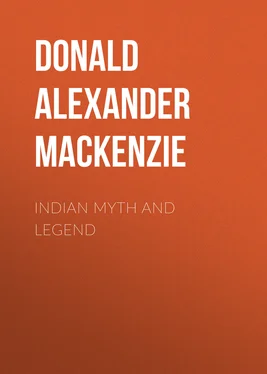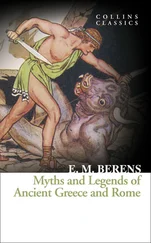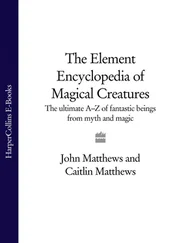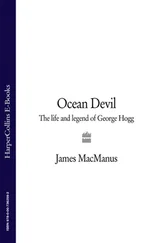Donald Alexander Mackenzie - Indian Myth and Legend
Здесь есть возможность читать онлайн «Donald Alexander Mackenzie - Indian Myth and Legend» — ознакомительный отрывок электронной книги совершенно бесплатно, а после прочтения отрывка купить полную версию. В некоторых случаях можно слушать аудио, скачать через торрент в формате fb2 и присутствует краткое содержание. Жанр: foreign_prose, foreign_religion, Философия, Мифы. Легенды. Эпос, foreign_psychology, foreign_antique, на английском языке. Описание произведения, (предисловие) а так же отзывы посетителей доступны на портале библиотеки ЛибКат.
- Название:Indian Myth and Legend
- Автор:
- Жанр:
- Год:неизвестен
- ISBN:нет данных
- Рейтинг книги:4 / 5. Голосов: 1
-
Избранное:Добавить в избранное
- Отзывы:
-
Ваша оценка:
- 80
- 1
- 2
- 3
- 4
- 5
Indian Myth and Legend: краткое содержание, описание и аннотация
Предлагаем к чтению аннотацию, описание, краткое содержание или предисловие (зависит от того, что написал сам автор книги «Indian Myth and Legend»). Если вы не нашли необходимую информацию о книге — напишите в комментариях, мы постараемся отыскать её.
Indian Myth and Legend — читать онлайн ознакомительный отрывок
Ниже представлен текст книги, разбитый по страницам. Система сохранения места последней прочитанной страницы, позволяет с удобством читать онлайн бесплатно книгу «Indian Myth and Legend», без необходимости каждый раз заново искать на чём Вы остановились. Поставьте закладку, и сможете в любой момент перейти на страницу, на которой закончили чтение.
Интервал:
Закладка:
A remarkable feature of post-Vedic religion in ancient India is the prominence given to the doctrine of metempsychosis (transmigration of souls) and the conception of the yugas or ages of the universe.
In the Rigveda the soul of the dead proceeds at once, or at any rate after burial, towards the next world. In one passage only is it spoken of “as departing to the waters or the plants”, and this reference, Professor Macdonell suggests, 38“may contain the germs of the theory” of transmigration. In the speculative prose treatises, the Upanishads , which were composed in the Middle Country, the doctrine of metempsychosis is fully expounded. It does not follow, however, that it originated in India although it may have obtained there unrecognized by the priestly poets who composed the hymns to the deities, long before it became an essential tenet of orthodox or official religion. Other representative communities of the Brown race professed this doctrine which appears to have evolved from the vague belief shared by more than one primitive race, that the souls of the dead, and especially of dead children, were ever on the outlook for suitable mothers. Even in Central Australia a particular tribe has perpetuated “the germs of the theory”, which may also be traced in the widespread custom of visiting standing stones at a certain phase of the moon to perform a ceremony so that offspring may be obtained. The Upanishadic doctrine of metempsychosis is less likely to have been so much coincidental as racial when we find that it is restricted to those areas where definite racial influences must have been at work. The Greeks believed in transmigration. So did also a section of the Egyptian people as Herodotus has stated and as is proved by references in folk-tales, temple chants and inscriptions. 39As we show ( Chapter VI Конец ознакомительного фрагмента. Текст предоставлен ООО «ЛитРес». Прочитайте эту книгу целиком, купив полную легальную версию на ЛитРес. Безопасно оплатить книгу можно банковской картой Visa, MasterCard, Maestro, со счета мобильного телефона, с платежного терминала, в салоне МТС или Связной, через PayPal, WebMoney, Яндекс.Деньги, QIWI Кошелек, бонусными картами или другим удобным Вам способом.
), the Irish conception closely resembled the Indian, and it also obtained among the Gauls. There is no trace, however, that the Teutonic peoples were acquainted with the fully developed doctrine of metempsychosis; the souls of the dead departed immediately to Valhal, Hela, or the loathsome Nifelhel.
The doctrine of the world's ages is common to the Indian, Greek, and Irish mythologies, but is not found in Teutonic mythology either. 40There are indications that it may have at one time obtained in Egypt, for there was an Age of Ra, then a deluge, an Age of Osiris, an Age of Set, &c.; but the doctrine, like other conceptions in Egypt, probably suffered from the process of priestly transformation in the interests of sectarian propaganda.
In India the ages are called the yugas, and this term has a totally different meaning in Vedic and Upanishadic times. Evidently the Bharata invasion and the establishment of the middle country power of their allies, the Kuru-Panchalas, was not unconnected with the introduction of the doctrines of metempsychosis and the yugas, and the prominence subsequently given to the worship of female deities.
If this theory can be established, we are confronted by an extremely interesting problem. It would appear that the mythology of the Vedic period bears a close resemblance to Teutonic, while that of the post-Vedic period connects more intimately with Greek, Celtic, and Egyptian. Assuming that the Vedic people were influenced by what we recognize as Teutonic modes of thought, do we find here proof that the Aryans came from Europe? In Chapter IIit is shown that the Norse Heimdal displays points of resemblance to Agni. The former, however, has been developed almost beyond recognition as a fire god, and it is evident that we find him in northern Europe in his latest and most picturesque form. On the other hand, there is no dubiety about the origin of the Vedic Agni.
The evidence afforded by archæology is highly suggestive in this connection. Scandinavia received its culture from the south at a comparatively late period in the Bronze Age, and it certainly exercised no intellectual influence in Europe in earlier times. Bronze is, of course, of less ethnic significance than beliefs, but it is difficult to believe, at the same time, that an isolated and poorly armed people could have imposed its intellectual culture over a wide area without having received anything in return. It is more probable that the northern Germanic peoples were subjected to the same influences which are traceable in their mythology and in the Vedic hymns, from a common source, and there may be more than mere mythology in the persistent tradition that the ancestors of the Teutons immigrated from Asia led by Odin. We need not assume that the movement was so much a racial as a cultural one, which emanated from a particular area where religious conceptions were influenced by particular habits of life and “immemorial modes of thought”. Among the settled and agricultural peoples of the Brown race, the development of religious ideas followed different lines, and were similarly controlled by early ideas which sprang from different habits and experiences.
In the opening chapters we present various phases of Aryan life and religion in India, beginning with the worship of Indra, and concluding with the early stages of modern Hinduism. From the ancient tribal struggles of the Middle Country accumulated the hero songs which received epic treatment in the Mahábhárata , while the traditions of the “Easterners” were enshrined in the Rámáyana . Although neither of these great works can be regarded as historical narratives, they contain a mass of historical matter which throws much light on the habits and customs and beliefs of the early peoples.
These epics were utilized by Brahmanical compilers for purposes of religious propaganda, and survive to us mainly as sacred books. In our pages we have given prominence to the heroic narrative which remains embedded in the mass of doctrinal treatises and mythological interpolations. The miraculous element is somewhat toned down in the accounts of conflicts, and the more dramatic phases of the heroic stories are presented in as full detail as space permits, so as to afford our readers glimpses of ancient life in northern India at a time when Vedic religion still held sway. This applies especially to the Mahábhárata , the kernel of which, no doubt, contains the hero songs of the Bharata and other tribes. The mythical conflicts of the Rámáyana appeal less to western minds than its purely human episodes. We cannot help being impressed by the chivalrous character of the leading heroes, the high sense of honour displayed by the princes, and the obedience shown by sons to their parents. We may weary of Rama's conflicts with giants and demons, but will long remember him as the child who pronounced his name as “'Ama” and cried for the moon, or sat on his father's knee at meetings of the State Council. Our interest will also abide with him as a lover and a faithful husband who suffered wrong. His brothers are noble and heroic characters, worthy of Shakespeare. But even the Bard of Avon never depicted more wonderful and fascinating women than the heroines of the Mahábhárata and Rámáyana . Our gallery includes, among others, the noble and self-sacrificing Savitri, who rescued her husband from the clutches of death by exercise of her strong love and devotion; the faithful and virtuous Sita, and the sorrowful and constant Damayantí, and beautiful Shakuntalá. In western literature romance usually ends with marriage; in India the devotion of wives is of more account than the yearnings of love-smitten Juliets on moonlight nights.
Читать дальшеИнтервал:
Закладка:
Похожие книги на «Indian Myth and Legend»
Представляем Вашему вниманию похожие книги на «Indian Myth and Legend» списком для выбора. Мы отобрали схожую по названию и смыслу литературу в надежде предоставить читателям больше вариантов отыскать новые, интересные, ещё непрочитанные произведения.
Обсуждение, отзывы о книге «Indian Myth and Legend» и просто собственные мнения читателей. Оставьте ваши комментарии, напишите, что Вы думаете о произведении, его смысле или главных героях. Укажите что конкретно понравилось, а что нет, и почему Вы так считаете.












